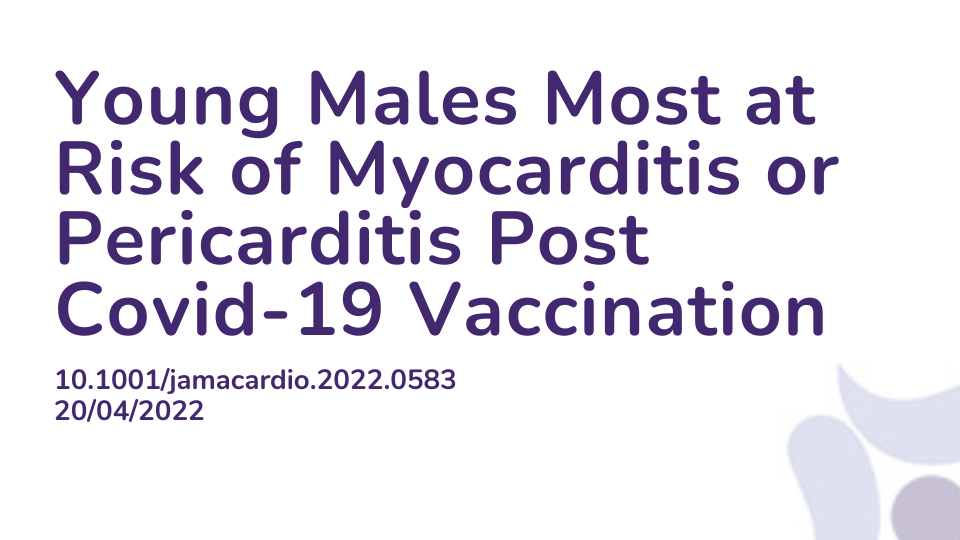Summary:
The purpose of this paper was to determine whether mRNA Covid-19 vaccinations are associated with the risk of myocarditis and pericarditis and which sex or age group are most at risk. Although these vaccinations have shown to be efficient at reducing the death rate of Covid-19, cases of myocarditis or pericarditis have been reported after one or two weeks of being vaccinated. After interpreting four cohort studies including over 23 million individuals who did not have a history of myocarditis or pericarditis, the results identified 1077 myocarditis events and 1149 pericarditis events post Covid-19 vaccination. The risk was highest in young males after the second vaccine dose.
Abstract:
Importance: Reports of myocarditis after SARS-CoV-2 messenger RNA (mRNA) vaccination have emerged. Objective: To evaluate the risks of myocarditis and pericarditis following SARS-CoV-2 vaccination by vaccine product, vaccination dose number, sex, and age. Design, Setting, and Participants: Four cohort studies were conducted according to a common protocol, and the results were combined using meta-analysis. Participants were 23 122 522 residents aged 12 years or older. They were followed up from December 27, 2020, until incident myocarditis or pericarditis, censoring, or study end (October 5, 2021). Data on SARS-CoV-2 vaccinations, hospital diagnoses of myocarditis or pericarditis, and covariates for the participants were obtained from linked nationwide health registers in Denmark, Finland, Norway, and Sweden. Exposures: The 28-day risk periods after administration date of the first and second doses of a SARS-CoV-2 vaccine, including BNT162b2, mRNA-1273, and AZD1222 or combinations thereof. A homologous schedule was defined as receiving the same vaccine type for doses 1 and 2. Main Outcomes and Measures: Incident outcome events were defined as the date of first inpatient hospital admission based on primary or secondary discharge diagnosis for myocarditis or pericarditis from December 27, 2020, onward. Secondary outcome was myocarditis or pericarditis combined from either inpatient or outpatient hospital care. Poisson regression yielded adjusted incidence rate ratios (IRRs) and excess rates with 95% CIs, comparing rates of myocarditis or pericarditis in the 28-day period following vaccination with rates among unvaccinated individuals. Results: Among 23 122 522 Nordic residents (81% vaccinated by study end; 50.2% female), 1077 incident myocarditis events and 1149 incident pericarditis events were identified. Within the 28-day period, for males and females 12 years or older combined who received a homologous schedule, the second dose was associated with higher risk of myocarditis, with adjusted IRRs of 1.75 (95% CI, 1.43-2.14) for BNT162b2 and 6.57 (95% CI, 4.64-9.28) for mRNA-1273. Among males 16 to 24 years of age, adjusted IRRs were 5.31 (95% CI, 3.68-7.68) for a second dose of BNT162b2 and 13.83 (95% CI, 8.08-23.68) for a second dose of mRNA-1273, and numbers of excess events were 5.55 (95% CI, 3.70-7.39) events per 100 000 vaccines after the second dose of BNT162b2 and 18.39 (9.05-27.72) events per 100 000 vaccines after the second dose of mRNA-1273. Estimates for pericarditis were similar. Conclusions and Relevance: Results of this large cohort study indicated that both first and second doses of mRNA vaccines were associated with increased risk of myocarditis and pericarditis. For individuals receiving 2 doses of the same vaccine, risk of myocarditis was highest among young males (aged 16-24 years) after the second dose. These findings are compatible with between 4 and 7 excess events in 28 days per 100 000 vaccines after BNT162b2, and between 9 and 28 excess events per 100 000 vaccines after mRNA-1273. This risk should be balanced against the benefits of protecting against severe COVID-19 disease.
Article Publication Date: 20/04/2022
DOI: 10.1001/jamacardio.2022.0583



